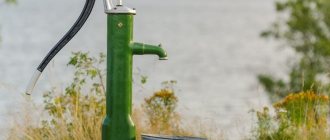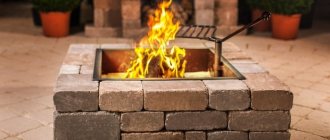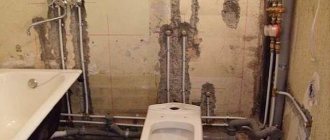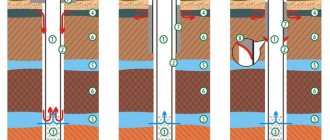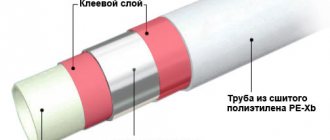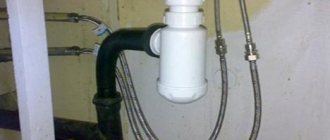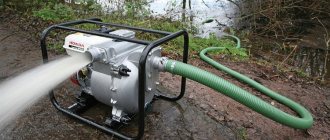Rising groundwater often leads to flooding of the local area, garden or vegetable garden. Excess moisture contributes to soil leaching, as a result of which the foundation sags and the house collapses. Constant dampness interferes with the development of cultivated plants and provokes the growth of lichens and mold.
The question arises, how to drain an area of groundwater if the water has nowhere to go? To prevent such a phenomenon, it is necessary to make drainage in an area with a high groundwater level (GWL). A number of reclamation works on the site can be done with your own hands, using purchased materials and improvised means.
When is it necessary to drain the area?
Large puddles appear in a suburban area when water does not seep into the ground during rains or floods. This happens if the soil is clayey or the groundwater level is high. And if the area is in a lowland, water flows onto it from above. The presence of large bodies of water or swamps nearby also affects the humidity level.
In all these cases, for normal living and harvesting, it is necessary to drain the area from groundwater. The problem can be detected in spring or autumn. Flooding usually occurs in the off-season, when the snow melts or there is a lot of rain. You can see places where moisture accumulates.
If a plot of land is purchased in the summer, you can also understand that it is flooded. This is detected by the following signs:
- doors and frames are warped, cracks are visible on the walls;
- smell of dampness, mold visible in the corners;
- there is water in the basement;
- a lot of mosquitoes, snakes, frogs;
- Weeds are dominated by nettle, wormwood, hemlock, and also a lot of reeds.
Prolonged accumulation of moisture near the house will lead to the appearance of mold, unpleasant odor, and deformation Source stroyfora.ru
Selecting a drying method
Often, a moisture problem is discovered after purchasing a property. It needs to be resolved as soon as possible, before the water damages buildings and destroys plants. It is not difficult to drain a swampy area of water, but choosing a method for this, you need to take into account several factors:
- cause of flooding;
- soil features;
- the depth of groundwater and the direction of its movement;
- presence of bodies of water nearby;
- size of the flooded area;
- presence of buildings and vegetation.
Each case may require different methods. For example, if the site is in a swampy area, raising it or installing an open drainage system will help. And when the groundwater level is high, closed drainage systems are used, possibly even with a well and a pump for their forced removal. This method is also used in areas that are located in lowlands.
Important ! After draining the area, it is recommended to enrich the soil with fertilizers, since all nutrients are washed out of it with water.
Before choosing a method for draining a site, you need to study the characteristics of the soil and the reasons for moisture accumulation Source aquakomfort-spb.ru
Drainage system
Structures made from drains are an excellent solution to the drainage problem. To drain a site using engineering structures, it will be necessary to create surface or deep watercourses into which liquid will be collected and discharged beyond its boundaries or into specially equipped containers. The structure may consist of wells or trenches with pipes that are connected in series into a single network; there are two types. The tasks of both options are similar - removing excess moisture, but the principles of their construction and operation occur differently.
How to arrange drainage
A drainage system is the most common and effective method of permanently draining a swamp in a summer cottage or near a country house. Drainage ensures the outflow of water outside the land. Typically, open or closed drainage systems are installed. There are also deep and point drainage, but they are used less frequently. The point of such drainage is that the water is discharged through a pipeline outside the site.
Open drainage
Open drainage is a system of ditches located on a slope. Through them, water flows into drainage wells or beyond the boundaries of the site. The distance between them is at least 6 m. It is better not to do them around buildings, this can lead to deformation of the foundation. Such ditches are made with sloping walls, the depth is at least 40-50 cm.
A variant of such a system is backfill drainage. The bottom of the ditch is laid out with geotextiles, then filled with gravel or stones to 2/3 of the depth. Fine gravel is poured on top, and then a layer of sand and soil.
The easiest way to drain the area is with trenches filled with gravel Source strojdvor.ru
This method is most often used if the soil is clayey. It helps drain water during floods and heavy rains, preventing the soil from becoming saturated with moisture. For soil with a lot of sand, this system is not used. This method is also not suitable for high groundwater levels.
The disadvantages of such a system include a reduction in the usable area of the site. This can be avoided by breaking a ditch near the fence. In addition, such trenches quickly become clogged with debris and leaves, and they have to be cleaned regularly.
See also: Catalog of companies that specialize in landscape design and gardening.
Closed drainage
A closed drainage system is a more complex but effective way to remove excess moisture. It will quickly help remove water and prevent its further accumulation. This method is also used to lower the groundwater level.
Closed drainage is installed using special PVC pipes buried in the ground. There are holes on their walls through which water from the soil enters them. To prevent clogging, the pipes are wrapped in geotextile. They need to be buried below the soil freezing level. The ditches are located at a slope, directed towards drainage wells.
What is quicksand and why is it so dangerous?
There are two types of quicksand, let's look at each to understand the difference.
True - in the soil, in addition to sand, there are particles of clay and silt, it is they that envelop the sand particles and act as a lubricant. Such a mass lies motionless until the internal underground pressure changes. Soils where true quicksands predominate contain clay, sand, sandy loam, and loam.
When digging a well or digging trenches for a foundation, there is always a chance of stumbling upon such an uninvited underground guest.
True quicksand has very low water yield due to clay, so the well will have to be dug in another place. The water will look like a clay-sand solution.
Why is a true quicksand dangerous?
- under its influence, depressurization of the well seams is possible
- water becomes undrinkable
- it is also not suitable for technical purposes
- possible shift of rings
- the soil around the well is subsiding
- quicksand under the house can lead to cracks in the walls and foundation
False - this type is not so dangerous; it contains a lot of sand and water. To make it move, hydraulic pressure must be created. If you come across this species on your way, it’s not as sad as with the first option. Since sandy masses predominate in its composition, this soil layer is very rich in moisture. This fact complicates the digging process and will create additional difficulties during operation.
Such layers are found in various soils, regardless of continent. Scientists are still arguing about this topic; no one knows the cause. So-called water saturation processes occur in soils, which are essentially quicksand. Our soils are gradually being washed away by quicksand, which leads to a deterioration in water supply.
Video description
You can see how to properly arrange drainage on a site in this video:
Step-by-step work on arranging a closed drainage system looks like this:
- First you need to plan on paper the optimal passage of the ditches. They should be located no closer than 2.5 m from trees.
- Then mark the area according to the plan.
- Dig trenches.
- Pour a layer of 10-15 cm of coarse sand.
- Lay geotextiles and pour gravel on it.
- Lay pipes wrapped in geotextile.
- Fill the space around the pipes with medium gravel until there is 20 cm left to the ground level.
- Cover with the edges of geotextile, fill the trench with small pebbles and soil.
To install a closed drainage system, special pipes are laid in trenches Source landscapevkazan.rf
Well
Another option for draining a swamp on a site is to make a waterproof well. You can build a well from concrete or from a large plastic container.
The well should be protected from clogging with geotest material. The water accumulated in the container can be used for irrigation or pumped out with a pump and discharged through laid pipes outside the site.
You can build a drainage system yourself, following the instructions given above. The cost of such work will be low, but the effect will be quite significant.
Construction of ponds, sewage pits or ditches
Owners of country houses are often interested in how to dry a plot of water with their own hands without drainage. This is also possible, but it is best to use such methods in the country, and not in a country house. This is digging ditches, sewage pits or decorative ponds. They can become not only a means of draining water, but also an element of landscape design. The choice of method depends on the characteristics of the site and the reason for the accumulation of moisture.
Note ! The disadvantage of this method is the need to regularly clean the resulting reservoirs. Without this, they will bloom, mosquitoes will appear, and there will be an unpleasant smell.
Wells
The easiest way is to dig holes in the lowest flooded areas. They should be cone-shaped, tapering downwards. The diameter at the surface is 2 m, the depth is at least 80-100 cm. Such pits can be decorated by turning them into decorative ponds. To avoid shedding and silting, their bottom is covered with gravel.
Ditches
Ditches are more difficult to dig, but such a system will drain excess water more efficiently. They are organized around the perimeter of the site. To prevent the walls from crumbling, they are reinforced with boards or concrete slabs. You can put a metal box on the bottom.
Drainage ditch beautifully designed to look like an artificial stream Source kndlandscaping.com
A variant of this drainage method is the installation of decorative streams. This is appropriate if the site is located on a slope. The bottom of the artificial stream is laid out with pebbles, pebbles or geotextiles. It is recommended to arrange streams under trees, as in a sunny place the water will bloom.
Moisture-loving plants
If you are wondering how to drain a site with your own hands at no cost, you can consider the option of planting moisture-loving plants. This method will be effective only in small swamps and if there is no urgent need to remove water.
By using plants that require a lot of water, you can lower the groundwater level and speed up the drying out of the area after rains and floods. This will also help decorate the area. Willow, maple, poplar, alder and birch are used.
If you need plants that grow faster, you can plant shrubs: hawthorn, viburnum, serviceberry, rose hips. This is an ideal way not only to reduce the amount of water on the site, but also to create a hedge. There are also moisture-loving herbaceous plants. These are perennial flowers: iris, aster, aquilegia. You can plant cranberries and blueberries.
To remove excess moisture, moisture-loving plants are planted on the site Source yandex.net
Groundwater level
Groundwater is free-flowing gravitational water that is located at a shallow depth from the surface of the earth. This is precisely the first aquifer.
When considering the depth of their occurrence, it is necessary to note the fact that small means constant seasonal fluctuations and changes. For example, when there is a significant amount of precipitation, the ground water level can rise significantly. Dry weather acts in the opposite way, reducing groundwater level. Such factors are determined by natural sources from which the waters are fed. These are standard precipitation, melted snow, rivers and other bodies of water located nearby.
Constantly fluctuating groundwater level is a serious problem for the owners of the site, because an increased level of moisture can harm country houses, gardens, vegetable gardens, flower beds and even the lawn, not to mention problems with the functioning of local wastewater treatment systems, artificial reservoirs, wells and wells.
Raising the area
If the groundwater level is high or if the area is very swampy, only raising the site can help. It is backfilled with soil. This is a complex and expensive method, but effective. It consists of several stages.
- Drawing up a detailed plan indicating aquifers, clayey areas, voids.
- Demolition of all buildings, clearing of debris.
- Laying a drainage system, preferably a closed type.
- Before backfilling begins, a strip foundation is laid around the perimeter of the site.
- Then the soil is covered in layers of 10-15 cm. Sand and crushed stone are usually used. Each layer is laid with geotextiles, compacted, and compacted. After this, you need to wait 2-3 weeks for the soil to shrink.
- Fertile soil is poured on top.
- Then you need to sow the soil with cereal crops. They have an extensive root system that will secure the fill.
To get rid of excess moisture, you may need to raise the level of the area Source marc2000.ru
Backfill
You can get rid of moisture by pouring a layer of sand over the entire area of the site. You need to start working by determining the highest point. It is necessary to take into account that you will need to raise the level by at least twenty centimeters.
Having calculated the required cubic capacity of the material, you should purchase construction sand and gravel. Sand, lying on the ground, squeezes out excess moisture, and its high drainage ability does not allow water to accumulate on the surface.
The final stage of the process - a fertile layer of soil is laid on top of the “pie” of sand and gravel on which any crops can be grown.
Briefly about the main thing
If the site is located on clay soils or in a lowland, it may need to be drained.
This procedure is complex, but quite feasible. If you choose the right drainage method, taking into account the characteristics of the soil and the depth of groundwater, you can get rid of the problem.
For this purpose, open or closed drainage is most often used, ensuring the outflow of water into drainage wells.
If the area is very waterlogged, it may need to be raised. And to get rid of moisture during rains, it is enough to plant moisture-loving plants on the site.
Ratings 0
Prevention measures
To extend the service life of the well and prevent the appearance of quicksand, you must adhere to the following rules:
- do not allow the water level to decrease by less than half (if the pressure created by the water decreases, the mine will collapse);
- monitor the bottom filter and change it after its service life has expired;
- clean the well at least once every 5 years;
- remove accumulated sand from the bottom of the well;
- use specialized equipment for cleaning.
It is prohibited to use any electrical appliances in the mine.

